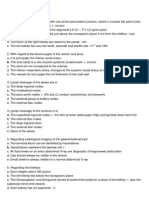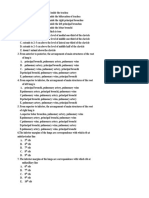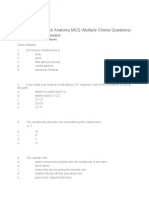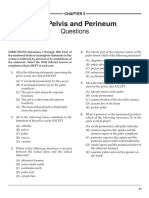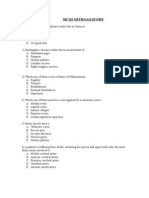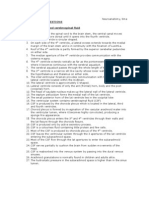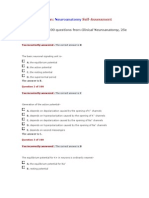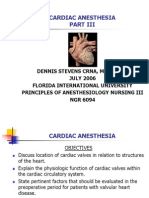Neuroanatomy
Neuroanatomy
Uploaded by
Eslam AlmassriCopyright:
Available Formats
Neuroanatomy
Neuroanatomy
Uploaded by
Eslam AlmassriCopyright
Available Formats
Share this document
Did you find this document useful?
Is this content inappropriate?
Copyright:
Available Formats
Neuroanatomy
Neuroanatomy
Uploaded by
Eslam AlmassriCopyright:
Available Formats
(Neuroanatomy) 1. The hypothalamus: a. forms part of the mid-brain b. forms part of the roof of the third ventricle c.
is responsible for temperature regulation d. contains the tuber cinerueum e. has nerve connections with the anterior lobe of the pituitary gland
2. The human pituitary gland: a. lies in the hypophyseal fossa of the sphenoid bone b. derives its blood supply from the circle of Willis c. is entirely ectodermal in origin d. has independent vascular systems for the anterior and posterior lobe e. has neural connections with the pineal body
3. The following hormones are secreted by the posterior pituitary gland: a. TSH b. growth hormone c. oxytocin d. antidiuretic hormone e. prolactin
4. The adult spinal cord: a. extends to the sacrum b. contains a central canal
c. is composed entirely of grey matter d. has a spinal ganglion in each dorsal nerve root e. is covered by three protective membranes
5. The pituitary gland : a. is situated above the optic nerve in the majority of patients b. if enlarged with adenoma can cause bitemporal hemianopia which is often larger superiorly than inferiorly c. has a portal circulation
d. contains pars nervosa in the anterior lobe e. increases in size during pregnancy
Refer to the picture above for the questions below.
1. The following are true: a. structure 1 is part of the ethmoid bone b. falx cerebri is attached to 1 c. structure 2 is part part of the frontal bone d. olfactory nerves pass through 2 e. nasal branch of the ophthalmic nerve passes through 2 2. The following are true: a. the pituitary gland rests on 5 b. 4 is the anterior clinoid process c. groove 8 is formed by internal carotid artery d. groove 10 is formed by the internal jugular vein e. groove 12 is formed by transverse venous sinus
3. The following are true about 3: a. it forms the superior border of the superior orbital fissure b. it is derived from the mesoderm c. it calcifies in membraneous. d. if forms the border between the anterior and middle cranial fossa. e. it may be absent in type I neurofibromatosis
4. Structures that passes through 6 include: a. middle meningeal artery b. mandibular branch of the trigeminal nerve c. internal carotid artery
d. sympathetic nerve e. facial nerve
5. Structures passing through 11 include: a. vertebral artery b. vagus nerve c. glossopharyngeal nerve d. hypoglossal nerve c. internal jugular vein
1. The trigeminal nerve: a. has three autonomic ganglia associated with its terminal branches b. has a large sensory and a small motor root c. carries taste fibres from the posterior one-third of the tongue d. has a mandibular division which leaves the skull through the foramen rotundum e. has maxillary division which is both sensory and motor
2. The trigeminal ganglion: a. lies in a depression on the petrous temporal bone b. has the internal carotid artery lying lateral to it c. contains the cell bodies of the sensory fibres of the fifth cranial nerve d. contains parasympathetic synapses e. lies entirely in the extradural space.
3. The maxillary nerve: a. is medial to the internal carotid artery in the cavernous sinus b. enters the orbit through the superior orbital fissure c. supplies sensation to the mucous membrane of the maxillary air sinus
d. supplies sensation to the lower lip e. supplies sensation to the lower eyelid.
4. Branches of the maxillary division of the trigeminal nerve include: a. the mental nerve b. the infraorbital nerve c. the supraorbital nerve d. the zygomaticofacial nerve e. the anterior ethmoidal nerve
5. Postganglionic fibres from the submandibular ganglion supply: the hyoglossus muscle b. taste buds on the tongue c. the facial artery d. sweat glands in the skin of the chin e. the sublingual salivary gland.
1. Structures found within the cerebellum include: a. the amygdaloid body b. the dentate nucleus c. the emboliform nucleus d. the caudate nucleus e. the globose nucleus
2. The fibres that interconnect the two cerebral hemispheres include: a. the cingulum b. the uncinate fasciculus c. the corpus callosum d. the hippocampal commissure e. the geniculo-calcarine tract
3. The following structures are made up of the dura mater: a. tela choroidea b. the cisterna magna c. the diaphragma sellae d. falx cerebelli e. falx cerebri
4. The following are true with regard to the internal capsule: a. it is made up of grey matter b. the anterior limb separates the caudate nucleus from the lenticular nucleus c. fibres connecting the frontal lobe to the red nucleus are found in the posterior limb d. corticothalamic fibres are found in the anterior limb e. contralateral spastic hemiplegia can result from infarction of the lenticulostriate artery
5. With regard to cerebral circulation: a. the posterior inferior cerebellar artery arises from the posterior cerebral artery b. the internal capsule is supplied by penetrating branches arising from the middle cerebral artery c. the posterior cerebral artery arises from the internal carotid artery d. the lateral aspect of each cerebral hemisphere is supplied mainly by the middle cerebral artery e. the inferior petrosal sinus drains into the external jugular vein
a.
You might also like
- Abdo & PelvisDocument15 pagesAbdo & PelvisAbid Khan100% (1)
- MCQ CNS AnatomyDocument7 pagesMCQ CNS AnatomyGroup 1491% (11)
- Pediatric Surgery Diagnosis and TreatmentDocument460 pagesPediatric Surgery Diagnosis and TreatmentPatricia Beznea100% (3)
- Upper and Lower Limb Anatomy QuestionsDocument8 pagesUpper and Lower Limb Anatomy QuestionsAnon Anon100% (1)
- Neuroanatomy McqsDocument20 pagesNeuroanatomy McqsNuman Khan0% (1)
- Dr:Khalid MiladDocument27 pagesDr:Khalid MiladMohsen Elzobna0% (1)
- Anatomy Forearm MCQDocument2 pagesAnatomy Forearm MCQthevampire20104825100% (1)
- NeuroanatomyDocument3 pagesNeuroanatomyModoro50% (2)
- Wiki Abdomen Mcqs ExplainedDocument9 pagesWiki Abdomen Mcqs Explainedchemptnk100% (2)
- Teach Yourself Lower LimbDocument32 pagesTeach Yourself Lower LimbSambili Tonny100% (2)
- Thorax ExamDocument3 pagesThorax ExamMarera DomnicNo ratings yet
- Teach Yourself Head and NeckDocument33 pagesTeach Yourself Head and NeckSambili Tonny100% (7)
- Aspects of The Novel PDF 933991Document6 pagesAspects of The Novel PDF 933991Dyno Buoy100% (1)
- Triage in The Emergency Department With PostersDocument27 pagesTriage in The Emergency Department With PostersSoleh RamlyNo ratings yet
- Pregnancy-Induced Hypertension CASE REPORTDocument31 pagesPregnancy-Induced Hypertension CASE REPORTMylene Angelie Bognot100% (2)
- Head and Neck McqsDocument3 pagesHead and Neck McqsRajitha DilhanNo ratings yet
- The Posterior Belly of The Digastric Muscle Is Innervated by A Branch of This Cranial Nerve: A. VDocument39 pagesThe Posterior Belly of The Digastric Muscle Is Innervated by A Branch of This Cranial Nerve: A. VghanimNo ratings yet
- Anatomy MCQ 1Document15 pagesAnatomy MCQ 1Maria75% (4)
- 25 MCQ NeuroDocument5 pages25 MCQ NeuroVaishnavi Singh100% (3)
- Head and Neck Test QuestionsDocument63 pagesHead and Neck Test QuestionsAbouzr Mohammed Elsaid100% (4)
- Neuroanatomy MCQDocument7 pagesNeuroanatomy MCQNishanthy Pirabakar0% (1)
- New ExamDocument15 pagesNew Exam_RedX_No ratings yet
- Anatss Final ExamDocument76 pagesAnatss Final ExamKarl Torres Uganiza RmtNo ratings yet
- Anatomy McqsDocument3 pagesAnatomy McqsJesna Jesna V100% (2)
- Anatomy Cns MCQs 11Document9 pagesAnatomy Cns MCQs 11علي. احمد100% (3)
- Fdocuments - in Neuroanatomy-McqsDocument28 pagesFdocuments - in Neuroanatomy-McqsRashee Goyal100% (1)
- Anatomy Mcqs (2) - 1Document13 pagesAnatomy Mcqs (2) - 1Yashfa Yasin - PharmDNo ratings yet
- Neuroanatomy Mcqs by DR Asif KhanDocument24 pagesNeuroanatomy Mcqs by DR Asif KhanMr .Hacker xDNo ratings yet
- Head Neck MCQ With Explanation - 5 PDFDocument5 pagesHead Neck MCQ With Explanation - 5 PDFMohamed Ghabrun100% (2)
- MCQS CNS-1Document5 pagesMCQS CNS-1Umer Ahmad100% (1)
- Head Neck McqsDocument22 pagesHead Neck McqsZllison Mae Teodoro Mangabat100% (2)
- Anatomy MCQSDocument13 pagesAnatomy MCQSdrpnnreddy100% (1)
- CNS MCQSDocument24 pagesCNS MCQSSTEVEN OKURUT100% (2)
- Practice Quiz Answers - Upper Limb, Axilla and Brachial PlexusDocument3 pagesPractice Quiz Answers - Upper Limb, Axilla and Brachial PlexusRobert EdwardsNo ratings yet
- Head Neck MCQ FinDocument60 pagesHead Neck MCQ FinMohamed Ghabrun100% (1)
- AnatomyDocument34 pagesAnatomyShubham Hiralkar100% (2)
- Pelvis and Perineum (Appleton & Lange Review)Document41 pagesPelvis and Perineum (Appleton & Lange Review)orea100% (2)
- QB-Neurophysiology 1st MidtermDocument19 pagesQB-Neurophysiology 1st MidtermJUANA ELIZABETH LOZA CASTRONo ratings yet
- Anatomy Upper Limb Q Bank MCQ 1Document10 pagesAnatomy Upper Limb Q Bank MCQ 1oofjd100% (1)
- MCQ of UpperDocument17 pagesMCQ of Upperد.مهاجر في أرض اللهNo ratings yet
- Branchial PlexusDocument7 pagesBranchial PlexusSuhas IngaleNo ratings yet
- Question Chapter 4 Spinal Cord and Ascending, Descending, and Interegmental TractsDocument17 pagesQuestion Chapter 4 Spinal Cord and Ascending, Descending, and Interegmental TractsTrang BuiNo ratings yet
- MCQS FatimaDocument8 pagesMCQS Fatimarawalian100% (2)
- Mcqs in Upper Limb: DR - Khalid MiladDocument10 pagesMcqs in Upper Limb: DR - Khalid MiladOzgan SüleymanNo ratings yet
- Lower Limb Mcqs MergedDocument148 pagesLower Limb Mcqs MergedCaim ZNo ratings yet
- AnatomyDocument4 pagesAnatomyFaisal AwanNo ratings yet
- Section (A) Answer The Following Questions by Choosing The Letter of The Best AnswerDocument6 pagesSection (A) Answer The Following Questions by Choosing The Letter of The Best AnswerAshraf Alamin AhmedNo ratings yet
- Anatomy MCQS: Abdomen: 1 BC 2 D 3 CD 4 B 5 D 6 A 7 C 8 D 9 E 10 BCD 11 CDE 12 BC 13 BCDDocument37 pagesAnatomy MCQS: Abdomen: 1 BC 2 D 3 CD 4 B 5 D 6 A 7 C 8 D 9 E 10 BCD 11 CDE 12 BC 13 BCDPeter BoatengNo ratings yet
- Final MCQ Form A ModifiedDocument5 pagesFinal MCQ Form A ModifiedhamdyyalyNo ratings yet
- Neuroanatomy MCQDocument7 pagesNeuroanatomy MCQi can always make u smile :D78% (9)
- MCQ Anatomy-thorax-Abdo-PelvisDocument100 pagesMCQ Anatomy-thorax-Abdo-PelvisMatt McCannNo ratings yet
- CNS Mcqs PDFDocument12 pagesCNS Mcqs PDFSindhi Waseem BalochNo ratings yet
- MCQ in AbdomenDocument4 pagesMCQ in AbdomenJayathra Liyanagamage100% (2)
- Open MCQ in Neuro-Anatomy دكتور عاشورDocument15 pagesOpen MCQ in Neuro-Anatomy دكتور عاشورstuffNo ratings yet
- Head Neck MCQ ChaptersDocument17 pagesHead Neck MCQ ChaptersMohamed GhabrunNo ratings yet
- Anatomy MCQDocument9 pagesAnatomy MCQAmmarah KhanNo ratings yet
- 3-Embryology of Respiratory SystemDocument25 pages3-Embryology of Respiratory SystemNur HikmahNo ratings yet
- Waxman - Neuroanatomy Self-Assessment MCQsDocument46 pagesWaxman - Neuroanatomy Self-Assessment MCQsNikunj94% (33)
- AnatomyDocument24 pagesAnatomydr.anoodabbasNo ratings yet
- 2nd Anatomy QuizDocument2 pages2nd Anatomy QuizbevorsiNo ratings yet
- Dent Final TestDocument6 pagesDent Final TestAnas AhmedNo ratings yet
- CNS - Credit 2020 - (04.12.2020)Document17 pagesCNS - Credit 2020 - (04.12.2020)0tahahmed5No ratings yet
- CNS - Final 2021 - (29.06.2021)Document7 pagesCNS - Final 2021 - (29.06.2021)0tahahmed5No ratings yet
- Hematologia - ResumosDocument48 pagesHematologia - ResumosKetlyn OliveiraNo ratings yet
- Counseling Your Patients About Tobacco Cessation PDFDocument4 pagesCounseling Your Patients About Tobacco Cessation PDFHamza KhanNo ratings yet
- Asa Physical Status Classification System PDFDocument2 pagesAsa Physical Status Classification System PDFGanda SilitongaNo ratings yet
- Jurnal HivDocument9 pagesJurnal Hivsheva25No ratings yet
- CARDIAC ANESTHESIA PART III - ds06Document30 pagesCARDIAC ANESTHESIA PART III - ds06Sayed NourNo ratings yet
- Anaesthesia Critical Care & Pain MedicineDocument26 pagesAnaesthesia Critical Care & Pain MedicineasiyazaidiaNo ratings yet
- DHMS Chronic - Illness - Benefit PDFDocument9 pagesDHMS Chronic - Illness - Benefit PDFNontobeko MkhizeNo ratings yet
- Fluid Balance in Clinical PracticeDocument8 pagesFluid Balance in Clinical Practicefernando_vaz2010100% (1)
- Sindh Nurses Examination Board KarachiDocument8 pagesSindh Nurses Examination Board KarachiBurhan uddin100% (13)
- Legal Medicine (Medical Jurisprudence To A Law Student)Document14 pagesLegal Medicine (Medical Jurisprudence To A Law Student)Look ArtNo ratings yet
- International Council of Ophthalmology's Ophthalmology Surgical Competency Assessment Rubrics (ICO-Oscar)Document4 pagesInternational Council of Ophthalmology's Ophthalmology Surgical Competency Assessment Rubrics (ICO-Oscar)Safa Abdualrahaman Ali HamadNo ratings yet
- Basalimplants 3 130724225029 Phpapp02Document26 pagesBasalimplants 3 130724225029 Phpapp02joephinNo ratings yet
- First Aid Bandaging & Splinting Simulator SpecificationsDocument7 pagesFirst Aid Bandaging & Splinting Simulator SpecificationsNyucel WellnessNo ratings yet
- Pelvic Inflammatory DiseaseDocument2 pagesPelvic Inflammatory Diseasejayinthelongrun100% (1)
- Anesthesiology PDFDocument9 pagesAnesthesiology PDFSubhadeep SarkarNo ratings yet
- Case Study Portfolio - MorehouseDocument22 pagesCase Study Portfolio - Morehouseapi-347779459No ratings yet
- The Birmingham Eye Trauma Terminology System (Bett) : Birminghamski Terminološki Sistem Očesnih Poškodb (Bett)Document3 pagesThe Birmingham Eye Trauma Terminology System (Bett) : Birminghamski Terminološki Sistem Očesnih Poškodb (Bett)Rahma Sha DyahNo ratings yet
- Amniotic FluidDocument5 pagesAmniotic FluidPat Cabanit0% (1)
- Thrombocytopaenia in Pregnancy: DR Guan Yong Khee Hospital MelakaDocument40 pagesThrombocytopaenia in Pregnancy: DR Guan Yong Khee Hospital MelakaNur Fadzilah100% (1)
- Surveys: Medicolegal Claims Against Anaesthetists: A 20 Year StudyDocument12 pagesSurveys: Medicolegal Claims Against Anaesthetists: A 20 Year StudyNguyen Duy ThanhNo ratings yet
- Puberty and The Tanner StagesDocument2 pagesPuberty and The Tanner StagesPramedicaPerdanaPutraNo ratings yet
- BSM Thru DM Curriculum CMO 33Document1 pageBSM Thru DM Curriculum CMO 33Jolas Aslor100% (1)
- New Assessment Tool Level 1 HospitalpdfDocument20 pagesNew Assessment Tool Level 1 HospitalpdfJim R. De JesusNo ratings yet
- Senate File 359Document3 pagesSenate File 359dmronlineNo ratings yet
- No Woman Should Die Giving LifeDocument112 pagesNo Woman Should Die Giving LifelibremdNo ratings yet
- Principles of Pain Management: Pediatric GuideDocument2 pagesPrinciples of Pain Management: Pediatric Guideblaziken123No ratings yet









